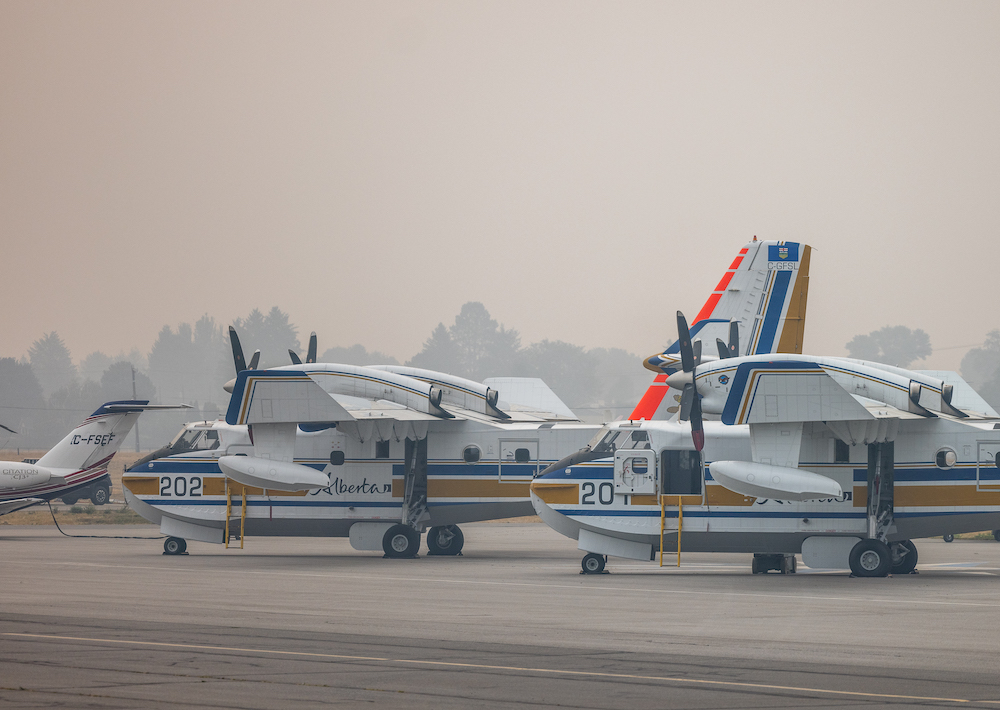
Opinion: A new age of wildfire requires new approaches – we gotta get on those now
November 2, 2023
By Glenn McGillivray
 Wildfire response in the B.C. Central Okanagan this year. Photo: BC Ministry of Emergency Management and Climate Readiness/Flickr.
Wildfire response in the B.C. Central Okanagan this year. Photo: BC Ministry of Emergency Management and Climate Readiness/Flickr. Parts of Canada have seen bad fire seasons in the past, but absolutely nothing compares to what was experienced this year. The 18.5 million hectares burned countrywide absolutely obliterated the previous record of 7.6 million hectares set in 1989.
And it begs the question: Will the 2023 fire season change our approach to fire management in Canada?
Typically, when we talk of a “bad fire season”, the discussion is often limited to British Columbia and/or Alberta, where active fire seasons are common. But this year crews were also exceptionally busy in the Yukon, Northwest Territories, Saskatchewan, Ontario, Quebec, New Brunswick, Nova Scotia and elsewhere.
Along with area-burned records being set in several places, the 2023 season saw Canadian wildfire smoke blanketing major cities like Vancouver, Seattle, Edmonton, Calgary, Chicago, Toronto and New York, wildfire evacuations numbering in the tens of thousands with Yellowknife being cleared for three weeks, and a significant number of structures lost in places not normally deemed to be high risk, like the Tantallon suburb of Halifax.
Currently, insured losses from Canadian wildfires this year sit at over $1 billion. Suppression costs exceed $1 billion for B.C. alone.
So can we look forward to some big changes in how we will manage wildfires in Canada going forward?
You may not want to hold your breath.
Unfortunately, it seems as though “the system” is designed to get us over the hump so we can move on, and nothing more.
But experts have been warning of a fire season like this year’s for at least a couple of decades. For one thing, we pointed out that Canada’s system of sharing fire suppression resources between provinces and territories would work as long as everyone wasn’t busy at the same time. But what would happen when everyone was too busy and scanty resources were already stretched to the limit?
As climate change continues to bite down, this problem is going to become more and more acute.
The same holds true with relying on the United States and other countries for assistance – it works as long as they aren’t busy too. We were lucky that the U.S. fire season began later this year, allowing the Americans to help us with our early season start. This became trickier further on in the season when they got busy at home, and some of our later requests for aid were denied.
We tend to rely a fair bit on crews from countries in the southern hemisphere, which has a fire season opposite to ours. Again, though, this can get tricky when many northern hemisphere countries are having bad fire seasons and competition for help is fiercer.
We have to ask the hard question: Can our system of reliance on mutual aid be sustained and what are the alternatives?
This year, ideas like creating a national wildland firefighting force and a national airtanker fleet have been knocked around. We must ask if these are worthy of a closer look.
Can we continue to lean on the Canadian Armed Forces as “backup muscle”, particularly as global political tensions indicate that using our army as a domestic disaster response force may not be tenable?
The overall problem of wildfire and personnel is a big one and, again, will become more and more problematic as climate change worsens.
In Canada, we rely quite heavily on summer students to fight wildfires. But what happens when fire seasons start earlier and earlier, when students are still in classes, and end later, after they are due back to college and university in early September?
A similar question must be asked of the volunteer wildland firefighters that are also relied on across the country, many of whom were stretched to the limits this year. How far can we push these assets and what happens when they reach their limits? Does it even make sense for a rich G7 country to rely on volunteers as much as we do?
Due to climate change, fires are more commonly raging through the overnight hours when, traditionally, they used to ease up, allowing fire crews to rest and regroup. Couple this with labour laws that limit the number of hours that crews can work in a day. Does climate change mean we will soon need to essentially double the crews we have now?
The same holds for air crews. With fires not easing up in the overnight as much anymore, and with Transport Canada restrictions on the number of hours crews can fly, will we need to double the number of air crews we have so that we can launch air operations in the overnight? How do we deal with pilot shortages? Do we need what we don’t have now to launch air attack in the overnight?
What about the big-picture issue of exhaustion and PTSD for all the above?
These are just a few of the essential questions that must be hashed out in Canada, sooner rather than later.
Other issues include the desperate need for a Canadian wildland fire building code, nationalization of FireSmart as the country’s premier wildfire mitigation program, and proper implementation of the Canada Wildland Fire Strategy, a still relevant and vital plan which has largely been left to languish since its signing by Canadian forest ministers more than 18 years ago.
We must enter into an open and honest multidisciplinary/multijurisdictional national dialogue about what the future state of wildfire management will look like if we don’t make bold changes now, and what those changes need to be for a sustainable desired future state.
We can’t keep cobbling together temporary solutions that just get us by.
We know what’s coming down the line, we’ve already been through a few dress rehearsals.
In many ways, 2023 was a test. And while we did manage to get over the hump again, there are going to be humps we may not be able to get over.
If we get on it now, we can still get our act together in time.
 Glenn McGillivray is managing director of the Institute for Catastrophic Loss Reduction and adjunct professor of disaster and emergency management at York University.
Glenn McGillivray is managing director of the Institute for Catastrophic Loss Reduction and adjunct professor of disaster and emergency management at York University.
Print this page